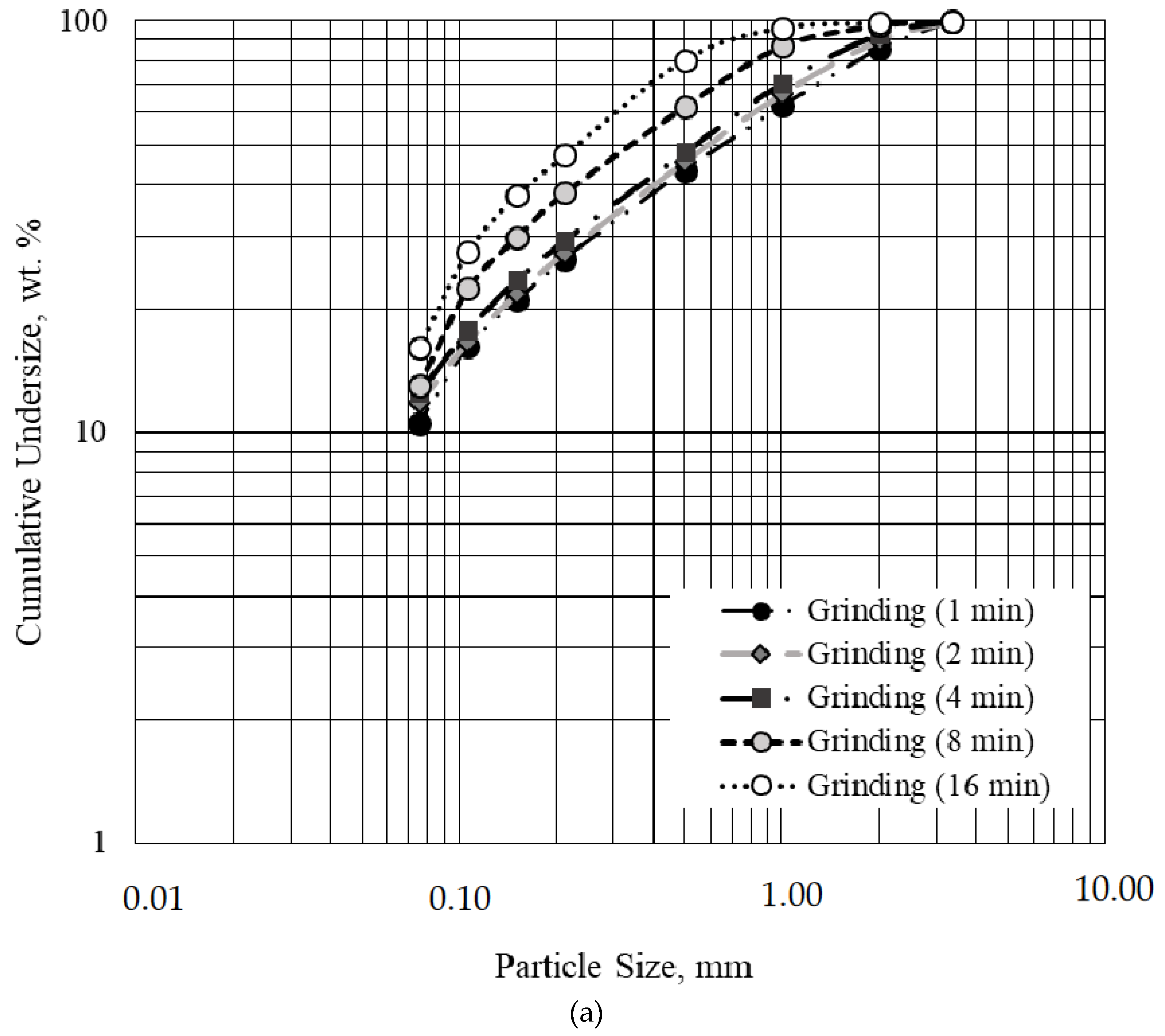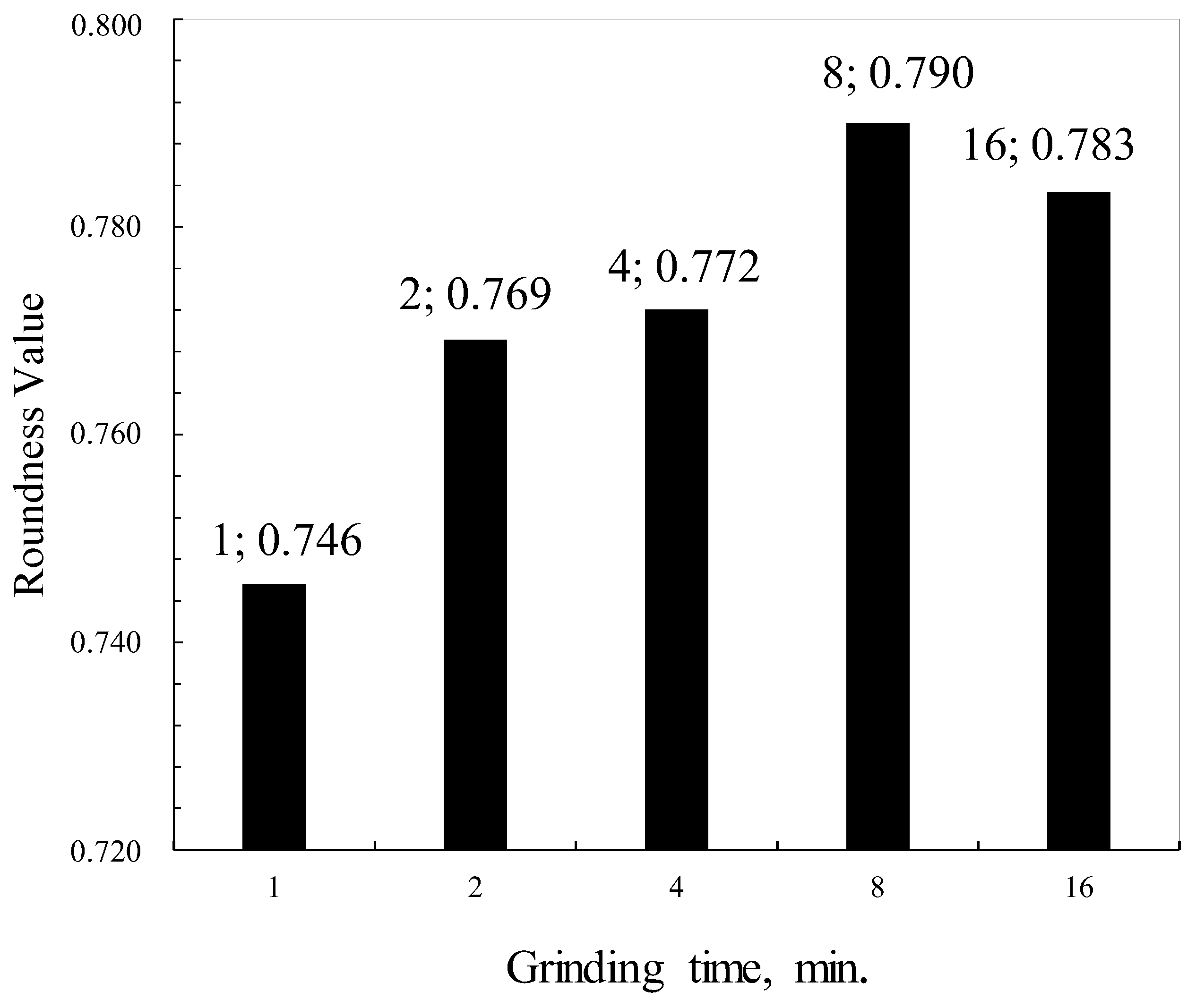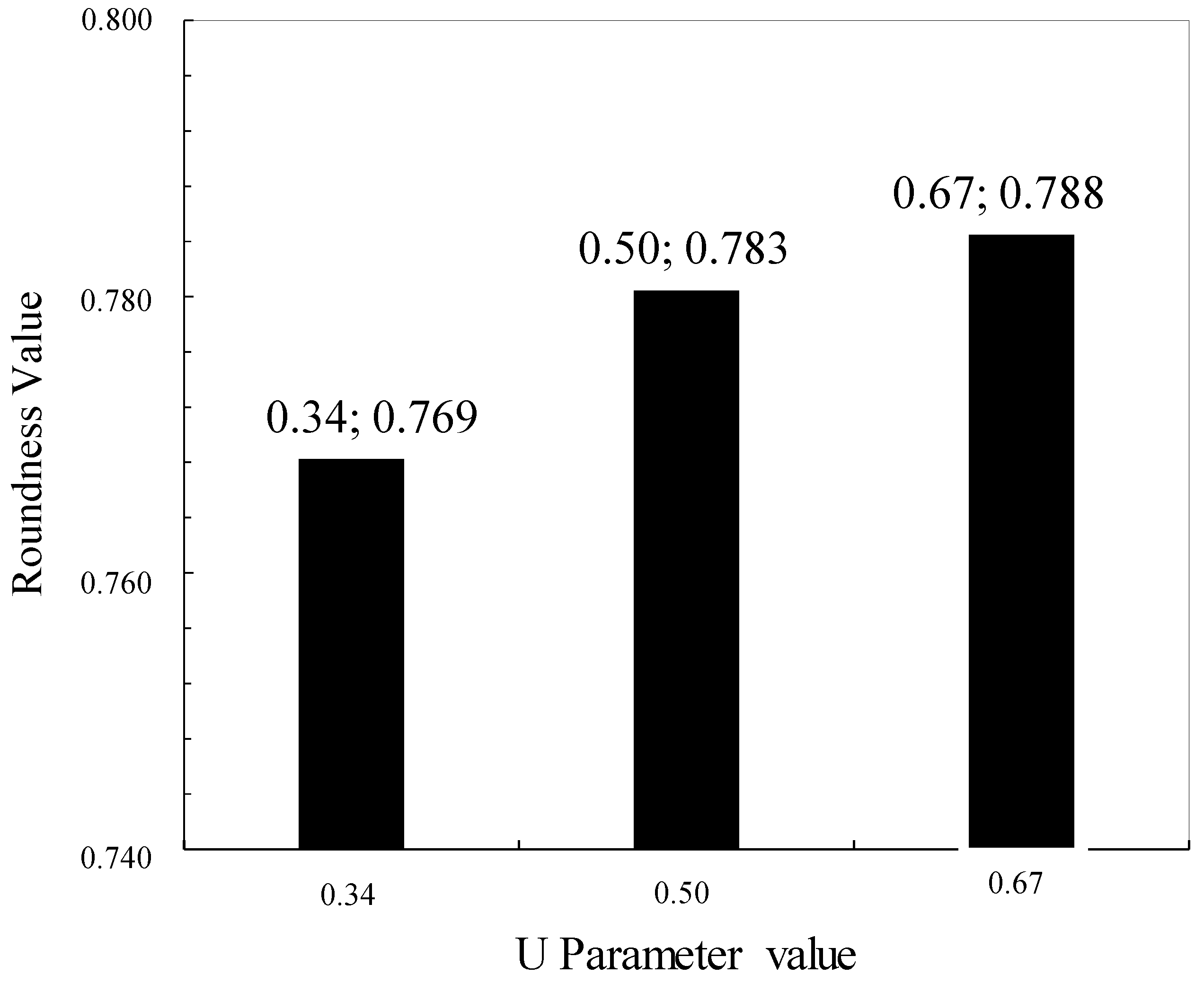The Effects of Ball-Mill Grinding Parameters on Lignite Morphology
Abstract
:1. Introduction
2. Materials and Methods
2.1. Preparation and Characterization of the Coal Sample
2.2. Morphological Analyses
2.3. Grinding Processes
3. Results and Discussion
3.1. Size Distribution Analyses
3.2. Shape Factor Analyses
3.3. Roughness Analysis
4. Discussion
5. Conclusions
- In the grinding tests performed depending on grinding time, it was determined that the roundness value of the lignite sample increased from 0.746 to 0.790 after 8 min of grinding while the d80 sizes of the ground products decreased from 1.6 mm to 0.85 mm. This result shows that grinding time not only plays a significant role in the size distribution of the lignite particles but also in the angular structural features that become round under the influence of the grinding media.
- In the tests performed with different U parameters in the same grinding time (16 min), it was determined that the roundness value of the lignite samples increased from 0.769 to 0.788 when the values of U parameters were 0.34 and 0.67, respectively. These results can be attributed to the increased amount of ground material.
- In the roughness values of particles determined with AFM as a function of grinding time, it was found that the material became rougher independently of the particles’ roundness structure. It was found that while the average roughness value of the lignite sample was 60.883 nm for 2 min of grinding time, it increased to 107.9 nm for 16 min of grinding time.
- As a result of this experimental study, it was found that the effects of grinding conditions on the morphology of other minerals should also be evaluated for lignite, and the morphological properties should also be considered for adjusting the grinding conditions to obtain a suitable size fraction for further processes.
Author Contributions
Funding
Data Availability Statement
Conflicts of Interest
References
- Hajkowicz, S.A.; Heyenga, S.; Moffat, K. The Relationship between Mining and Socio-Economic Well-Being in Australia’s Regions. Resour. Policy 2011, 36, 30–38. [Google Scholar] [CrossRef]
- Roy, S.K.; Nayak, D.; Rath, S.S. A Review on the Enrichment of Iron Values of Low-Grade Iron Ore Resources Using Reduction Roasting-Magnetic Separation. Powder Technol. 2020, 367, 796–808. [Google Scholar] [CrossRef]
- Little, L.; Mainza, A.N.; Becker, M.; Wiese, J. Fine Grinding: How Mill Type Affects Particle Shape Characteristics and Mineral Liberation. Miner. Eng. 2017, 111, 148–157. [Google Scholar] [CrossRef]
- Govender, N.; Rajamani, R.; Wilke, D.N.; Wu, C.-Y.; Khinast, J.; Glasser, B.J. Effect of Particle Shape in Grinding Mills Using a GPU Based DEM Code. Miner. Eng. 2018, 129, 71–84. [Google Scholar] [CrossRef]
- Mathe, E.; Cruz, C.; Lucay, F.A.; Gálvez, E.D.; Cisternas, L.A. Development of a Grinding Model Based on Flotation Performance. Miner. Eng. 2021, 166, 106890. [Google Scholar] [CrossRef]
- Ahmed, M.M. Effect of Comminution on Particle Shape and Surface Roughness and Their Relation to Flotation Process. Int. J. Miner. Process. 2010, 94, 180–191. [Google Scholar] [CrossRef]
- Qian, H.Y.; Kong, Q.G.; Zhang, B.L. The Effects of Grinding Media Shapes on the Grinding Kinetics of Cement Clinker in Ball Mill. Powder Technol. 2013, 235, 422–425. [Google Scholar] [CrossRef]
- Ulusoy, U.; Hiçylmaz, C.; Yekeler, M. Role of Shape Properties of Calcite and Barite Particles on Apparent Hydrophobicity. Chem. Eng. Process. Process Intensif. 2004, 43, 1047–1053. [Google Scholar] [CrossRef]
- Verrelli, D.I.; Koh, P.T.L.; Bruckard, W.J.; Schwarz, M.P. Variations in the Induction Period for Particle-Bubble Attachment. Miner. Eng. 2012, 36–38, 219–230. [Google Scholar] [CrossRef]
- Cheng, G.; Xu, H.; Huang, G.; Yuan, C.; Feng, X. The Effect of Grinding Time on Difficult-to-Float Coal. Adv. Mater. Res. 2013, 826, 136–139. [Google Scholar] [CrossRef]
- Xia, W. Role of Particle Shape in the Floatability of Mineral Particle: An Overview of Recent Advances. Powder Technol. 2017, 317, 104–116. [Google Scholar] [CrossRef]
- Ulusoy, U.; Yekeler, M.; Hiçyılmaz, C. Characterization of Shape, Roughness, and Wettability of Calcite Mineral. Sci. Min. J. 2004, 43, 11–24. [Google Scholar]
- Yekeler, M.; Ulusoy, U.; Hiçyılmaz, C. Effect of Particle Shape and Roughness of Talc Mineral Ground by Different Mills on the Wettability and Floatability. Powder Technol. 2004, 140, 68–78. [Google Scholar] [CrossRef]
- Guven, O.; Kaymakoğlu, B.; Ehsani, A.; Hassanzadeh, A.; Sivrikaya, O. Effects of Grinding Time on Morphology and Collectorless Flotation of Coal Particles. Powder Technol. 2022, 399, 117010. [Google Scholar] [CrossRef]
- Karakas, F.; Vaziri Hassas, B. Effect of Surface Roughness on Interaction of Particles in Flotation. Physicochem. Probl. Miner. Process. 2016, 52, 18–34. [Google Scholar] [CrossRef]
- Guven, O.; Çelik, M.S. Interplay of Particle Shape and Surface Roughness to Reach Maximum Flotation Efficiencies Depending on Collector Concentration. Miner. Process. Extr. Metall. Rev. 2016, 37, 412–417. [Google Scholar] [CrossRef]
- Jakovac, M.; Klaser, T.; Radatović, B.; Bafti, A.; Skoko, Ž.; Pavić, L.; Žic, M. Impact of Sandblasting on Morphology, Structure and Conductivity of Zirconia Dental Ceramics Material. Materials 2021, 14, 2834. [Google Scholar] [CrossRef]
- Verrelli, D.I.; Bruckard, W.J.; Koh, P.T.L.; Schwarz, M.P.; Follink, B. Particle Shape Effects in Flotation. Part 1: Microscale Experimental Observations. Miner. Eng. 2014, 58, 80–89. [Google Scholar] [CrossRef]
- Rezai, B.; Rahimi, M.; Aslani, M.R.; Eslamian, A.; Dehghani, F. Relationship between Surface Roughness of Minerals and Their Flotation Kinetics; National Metallurgical Laboratory: Jamshedpur, India, 2010; pp. 232–238. [Google Scholar]
- Yin, W.; Zhu, Z.; Yang, B.; Fu, Y.; Yao, J. Contribution of Particle Shape and Surface Roughness on the Flotation Behavior of Low-Ash Coking Coal. Energy Sources Part A Recover. Util. Environ. Eff. 2019, 41, 636–644. [Google Scholar] [CrossRef]
- Guven, O. The Effect of Shape and Roughness on Flotation and Aggregation of Quartz Particles. Physicochem. Probl. Miner. Process. 2022, 58, 154021. [Google Scholar] [CrossRef]
- Kaymakoğlu, B.; Sivrikaya, O. Investigation of the Effects of Different Drying Methods on Coal Grindability. Adana Alparslan Turkes Sci. Technol. Univ. J. Sci. 2021, 4, 31–42. [Google Scholar]
- Kadıköylü, Ş. Determination of Mineral Matter Content in Some Turkish Coals (Turkish: Bazı Türk Kömürlerinde Mineral Madde Miktarının Belirlenmesi). Master’s Thesis, Çukurova University, Adana, Turkey, 2005. [Google Scholar]
- Ghalehjough, K.B.; Akbulut, S.; Çelik, S. Experimental and numerical investigation on bearing capacity of granular soil affected by particle roundness. Indian J. Geo Mar. Sci. 2017, 46, 2137–2145. [Google Scholar]
- Ulusoy, U.; Igathinathane, C. Dynamic Image Based Shape Analysis of Hard and Lignite Coal Particles Ground by Laboratory Ball and Gyro Mills. Fuel Process. Technol. 2014, 126, 350–358. [Google Scholar] [CrossRef]
- Feng, D.; Aldrich, C. A Comparison of the Flotation of Ore from the Merensky Reef after Wet and Dry Grinding. Int. J. Miner. Process. 2000, 60, 115–129. [Google Scholar] [CrossRef]
- Koh, P.T.L.; Hao, F.P.; Smith, L.K.; Chau, T.T.; Bruckard, W.J. The Effect of Particle Shape and Hydrophobicity in Flotation. Int. J. Miner. Process. 2009, 93, 128–134. [Google Scholar] [CrossRef]
- Ulusoy, U. Quantifying of Particle Shape Differences of Differently Milled Barite Using a Novel Technique: Dynamic Image Analysis. Materialia 2019, 8, 100434. [Google Scholar] [CrossRef]
- Ulusoy, U.; Yekeler, M.; Gülsoy, O.Y.; Aydoğan, N.A.; Biçer, C.; Gülsoy, Z. Review on the Applications of Apparent Mean Shape Factor on the Integration of Coarse and Fine PSDs Measured by Different Techniques: Quartz Example. Curr. Work. Miner. Process. 2019, 1, 30–42. [Google Scholar] [CrossRef]
- Vishnoi, N.; Mohapatra, S.K. Study of Particle Size Distribution of Pulverized Coals in Utility Boilers. Part. Sci. Technol. 2018, 36, 999–1005. [Google Scholar] [CrossRef]






| Parameters | Units | Values | ||
|---|---|---|---|---|
| Mill volume | cm3 | 4832 | 4832 | 4832 |
| Ball weight | g | 5227 | 5227 | 5227 |
| Ball apparent density | g/cm3 | 4.01 | 4.01 | 4.01 |
| Ball diameter | cm | 3.00 | 3.00 | 3.00 |
| Bulk density of the material | g/cm3 | 0.84 | 0.84 | 0.84 |
| Ball charge rate (j) | - | 0.45 | 0.45 | 0.45 |
| U | - | 0.34 | 0.50 | 0.67 |
| Material charge rate (Fc) | - | 0.06 | 0.09 | 0.12 |
| Material weight | g | 248 | 365 | 489 |
Disclaimer/Publisher’s Note: The statements, opinions and data contained in all publications are solely those of the individual author(s) and contributor(s) and not of MDPI and/or the editor(s). MDPI and/or the editor(s) disclaim responsibility for any injury to people or property resulting from any ideas, methods, instructions or products referred to in the content. |
© 2023 by the authors. Licensee MDPI, Basel, Switzerland. This article is an open access article distributed under the terms and conditions of the Creative Commons Attribution (CC BY) license (https://creativecommons.org/licenses/by/4.0/).
Share and Cite
Guven, O.; Ehsani, A.; Kaymakoğlu, B. The Effects of Ball-Mill Grinding Parameters on Lignite Morphology. Minerals 2023, 13, 1185. https://doi.org/10.3390/min13091185
Guven O, Ehsani A, Kaymakoğlu B. The Effects of Ball-Mill Grinding Parameters on Lignite Morphology. Minerals. 2023; 13(9):1185. https://doi.org/10.3390/min13091185
Chicago/Turabian StyleGuven, Onur, Arman Ehsani, and Burçin Kaymakoğlu. 2023. "The Effects of Ball-Mill Grinding Parameters on Lignite Morphology" Minerals 13, no. 9: 1185. https://doi.org/10.3390/min13091185





